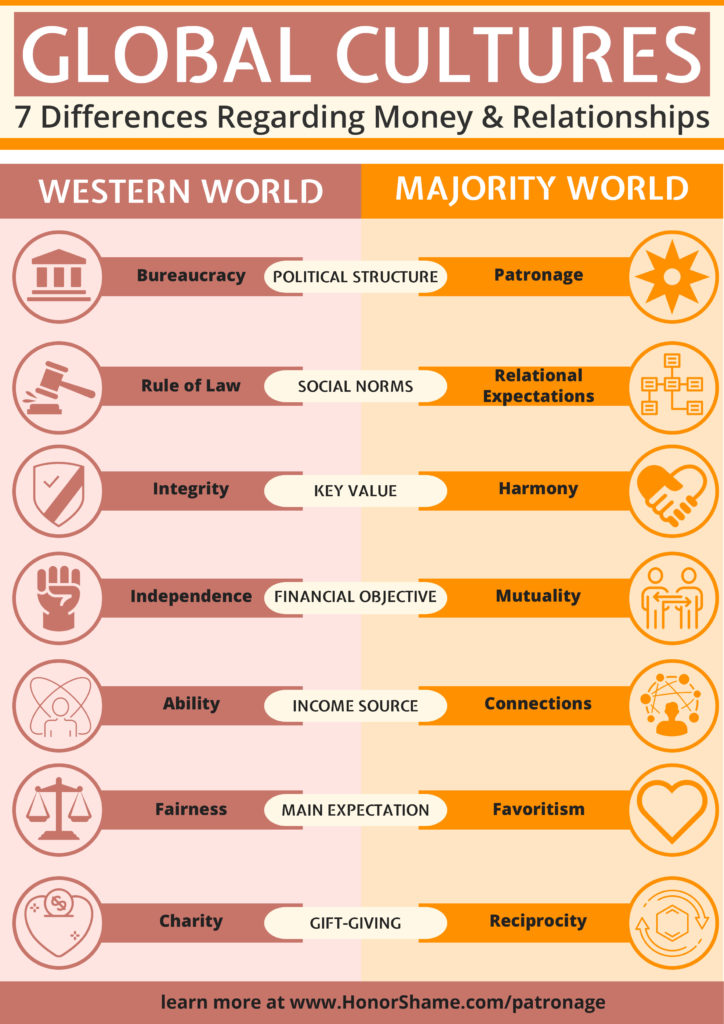$$ Infographic: 7 Differences in Global Cultures
Patronage frustrates many people, especially Westerners. Why is patronage so frustrating? Fundamental cultural differences between patronage and Western economics create an inevitable cultural clash.
Each cultural system is like a rulebook for playing a board game. Each player assumes others will “play by the rules.” But once the game starts, it becomes evident the players have different, even contradicting, rulebooks for the relationship. This metaphor explains the nature of cultural tensions—cultures assume differing “rules” for how life should function. To get at the root of the cultural tensions, this section contrasts seven key differences between the cultural rulebooks of Western and Majority World socioeconomic systems. Remember, these seven contrasts describe the end points of a broad continuum. They are general social patterns, not absolute rules.
The infographic below explains the 7 core differences regarding money and relationships between Western and Majority World cultures. The general category is in the middle in white, and on each side are the assumed rules/values of each culture.

I created this infographic myself for others to freely download, print, use, and share. No permission is needed. Click these links to download hi-resolution JPG’s of the infographic in color and grayscale version.
For a complete explanation of these cultural differences, see Chapter 3, “Misperceptions of Patronage,” in my book Ministering in Patronage Cultures (IVP Academic, 2019). For more resources about patronage, visit https://honorshame.com/patronage/.

I am dealing with this very issue right now. But my question is, what if “Harmony” is breaking bibilical rules (i.e. they are lying to keep harmony.) When does the Westerner say, “Sorry, that’s going to far”?
Every multi-cultured mission teams should discuss this and how it affects their working together and living out the biblical “one-another” commands.
Thanks for this clear graphic. Here’s an example.
Matthew 1:19 says: “But Joseph her husband, being righteous AND not wishing to shame her, decided to divorce her secretly.”
Westernized translators of NIV, having in mind for ‘righteous’ only integrity and the rule of law, see a contradiction here, so smooth it out by translating as: “Because Joseph her husband was faithful to the law, and YET did not want to expose her to public disgrace, he had in mind to divorce her quietly.” (Similarly, NIRV inserts “but”, in place of “and”.)
But God’s righteousness is also a relational, saving righteousness, which produces harmony. So Joseph acted righteously in not wanting to shame her in public.
Yes, well spotted. There is no need to see any contradiction between Joseph’s proclivity for “doing the right thing” and avoiding all slander/trial of Mary. According to the infographic the correct response would be for Joseph to consider his relational responsibility to Mary, and to the child that is not his, and to the unknown father.
So his obligation would be to consider whether it would actually be right/appropriate to assume the role of father by pretending that the child really was his (hardly fair to the child or whose child it was).
Even the commentaries miss this entirely.
After having lived overseas, I personally prefer the Western World approach over the Majority World approach. Both have their positives and negatives, but I certainly saw abuses, incompetence, etcetera that were directly tied to the Majority World approach.
Every multi-cultured missions team needs to discuss what this means to them and how it affects their working together as well as how they see this in living out the ‘one-another’ commands of scripture.